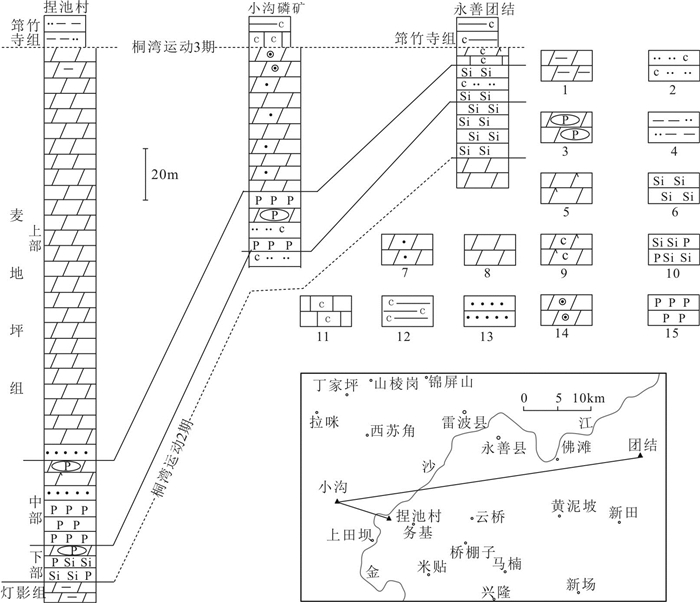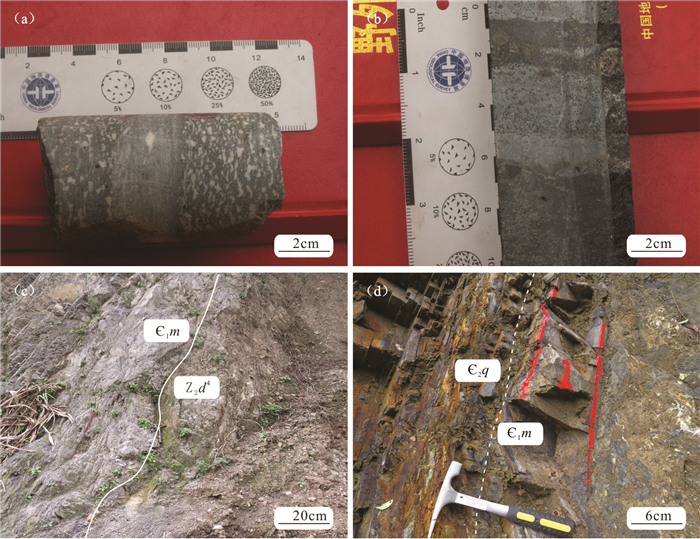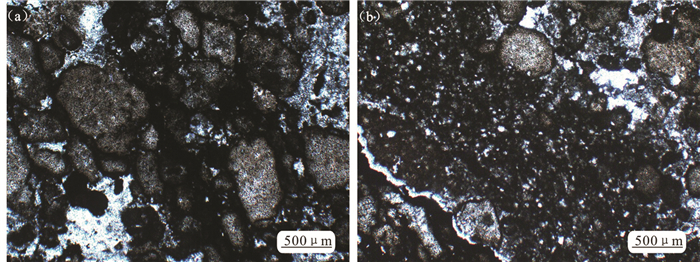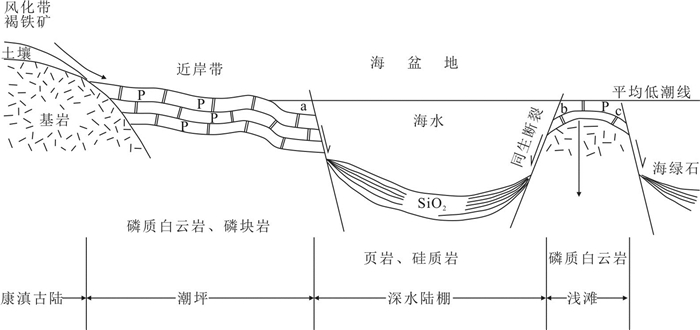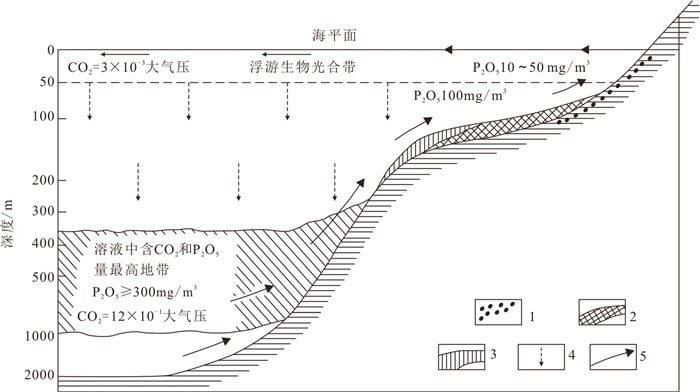Phosphorus-bearing strata in Maidiping Formation of the Lower Cambrian in Leibo area of Sichuan Province and its potential of phosphate resources
-
摘要:研究目的
四川省雷波县至云南省永善县是寒武系麦地坪组磷矿聚集区,含磷地层的研究不仅有助于深入分析磷矿形成的古地理环境及其变化特征,而且结合构造背景的研究,可研究磷矿形成分布规律,为磷矿的开发提供理论依据。
研究方法以岩心编录及剖面测量为基础,研究了雷波地区麦地坪组含磷层系厚度、岩性、沉积相、沉积模式、构造背景、盆地性质、磷矿成因机制、磷块岩岩石学特征及其变化等。
研究成果阐明了雷波地区麦地坪组在50km范围内,岩性、岩相的巨大差异以及磷块岩特征,指出雷波地区在麦地坪组沉积时期呈隆、凹相间的格局,缺失浅水陆棚相。白云岩相区属潮坪相,是磷矿聚集的有利地段。硅质岩属深水陆棚相,是火山活动形成的热水作用成因。磷矿的聚集是硅质岩相区火山活动,生物发育,高温洋流由下向上运动,携带生物遗体分解的高P2O5浓度海水在凹陷区两侧白云岩相区沉积和改造的结果。从大地构造背景、盆地性质、磷质来源、磷的迁移、沉淀、富集阐述了磷矿成矿作用机制,提出雷波地区磷矿是多种因素作用形成,建立了相应的磷矿成矿模式。
结论发现揭示了新元古代末期至寒武纪早期,裂谷盆地发育的晚期阶段,一种新的磷成矿作用——隆、凹相间的古地理格局及微弱的火山活动,在空间上有效配置,并由此提出在凹陷两侧白云岩相区寻找磷矿的预测评价新思路,指出针对麦地坪组磷矿找矿的新方向,在找矿空间可由凹陷区向四周拓展。
创新点:阐明了雷波地区麦地坪组岩性、岩相及磷块岩特征是差异隆升的结果,属裂谷盆地成因;提出了白云岩形成磷块岩新的多因素成矿作用,建立了雷波地区磷块岩多因素成矿作用模式;提出了裂陷槽边缘白云岩建造中寻找磷矿预测评价的新思路。
Abstract:This paper is the result of mineral exploration engineering.
ObjectiveThe phosphate deposit accumulation scope of Maidiping Formation of the Lower Cambrian covers a wide area from Leibo County (Sichuan) to Yongshan County (Yunnan). The study of phosphorus-bearing strata is not only helpful to the reconstruction of the paleogeographic environment and its varied characteristics, but also can obtain the formation and distribution of phosphate deposits in combination with the study of tectonic background, and provide a thedeposittical basis for the development of phosphate deposit.
MethodsBased on the cdeposit record and section measurement, this paper studies the thickness, lithology, sedimentary facies, sedimentary model, tectonic background, basin properties, genetic mechanism of phosphate deposit, petrological features of phosphorite, and their changes in Maidiping Formation in Leibo area.
ResultsThe significant difference of lithology and lithofacies of the Maidiping Formation in Leibo area are within 50 kilometers, and the characteristics of phosphorite are well explained. It is pointed out that the Leibo area was an uplift and depression environment during the sedimentary period of Maidiping Formation, and the shallow shelf facies was absent. Dolomite facies area belongs to tidal flat facies, which is a favorable area for the phosphate deposit accumulation. Siliceous rocks belong to deep-water shelf facies and are of hydrothermal origin formed by volcanic activity. The accumulation of phosphorite is the result of volcanic activity in siliceous lithofacies area, biological development, movement of high temperature ocean current from the bottom to the top, sedimentation of the seawater with high P2O5 carried by ocean current decomposing biological remains in dolomite facies area on both sides of the sag area and post-sedimentation transformation. Based on the tectonic background, basin nature, source of phosphorus, migration, sedimentation and enrichment of phosphorus, the deposit-forming mechanism of phosphate is described, and the formation of phosphate deposit in Leibo area is suggested by the interaction of many factors, and the corresponding deposit-forming model of phosphate deposit is established. The siliceous rocks in the depression are the result of the hot water activity under volcanism.
ConclusionsThe study revealed a new phosphorus mineralization style in the late stage of rift basin development from Late Neoproterozoic to Early Cambrian, i.e., the paleogeographic pattern of alternating uplift and depression with the weak volcanic activity. A new idea of predicting and evaluating the phosphate deposit in dolomite facies area on both sides of the depression is put forward. We suggest that the prospecting space of the Maidiping Formation phosphate deposit should be expanded from the depression area to the surrounding areas.
-
1. 引言
地下水氮污染是全球性的环境问题(Hu et al., 2005)。天然条件下,地下水中的氮尤其是铵态氮含量低,然而在城镇化进程中,受生活污水、工业废水、禽畜养殖场、化粪池及垃圾填埋场淋滤液泄漏影响,地下水中的铵态氮含量明显升高(刘兴权等,2010;杨静等,2018;徐进等,2018;苗晋杰等,2020)。地下水中NH4+质量浓度小于10 mg/L称为含铵地下水,NH4+质量浓度大于10 mg/L称为高铵地下水,而NH4+质量浓度超过30 mg/L的地下水称为高铵“肥水”(支兵发,2015)。高浓度的铵态氮对生活饮用水安全及生态环境存在潜在威胁。饮用水中的铵态氮会降低消毒效果,可转化为致癌的亚硝酸盐,也可转化为氨气引起水生物的死亡。此外,高铵地下水补给地表水会引起水生系统的富营养化(Du et al., 2017a)。高铵地下水的来源与成因是国内外学者研究的热点(支兵发,2015;杜尧,2017),城镇化地区高铵地下水铵氮来源复杂,相比较硝态氮和亚硝态氮,高浓度的铵态氮有各种人为来源,而天然沉积环境是造成高铵地下水的主要成因(Lingle et al., 2017;Du et al., 2017a)。
珠江三角洲是中国沿海地带经济飞速发展的地区。区内河网密布,地下水与地表水水力联系密切。工业化和城镇化的快速发展带来了地表水环境问题,同时对地下水环境也形成了潜在威胁。生活污水、工业废水无序排放,人畜粪便的淋滤下渗等导致地下水“三氮”污染突出,局部地区出现面状污染(Zhang et al., 2020)。高铵地下水在三角洲平原地区分布普遍,多赋存于洼地、谷地的第四系含水层底部。珠江三角洲高铵地下水基本形成于中全新世早期,与古海水的退积过程关系密切,迟缓的水循环条件和地下还原环境有利于高铵地下水的赋存(支兵发,2015)。然而,城镇化进程中,在原生沉积环境和人类活动双重作用下,研究区高铵地下水铵氮来源及赋存机制还鲜有报道。基于此,本文以珠江三角洲为研究区,综合多方面水文地质调查数据,运用数理统计、离子相关性分析等方法,探讨珠江三角洲地区高铵地下水赋存环境特征、驱动因素及城镇化扩张对三角洲地下水铵氮含量的影响。以期对珠江三角洲地区地下水资源的合理开发提供参考,也为沿海三角洲地区高铵地下水的研究提供借鉴。
2. 材料与研究方法
2.1 研究区水文地质概况
珠江三角洲地区位于广东省中南部,东、西、北三面低山、丘陵环绕,中南部为三角洲平原区陆地总面积约42000 km2。研究区属亚热带季风气候区,年平均气温23.2℃;年平均降水量1800~2200 mm,受季风气候影响,集中在4—9月。珠江三角洲属华南褶皱系粤北、粤中坳陷带;地层以泥盆系、石炭系、二叠系、侏罗系、第四系为主,其中第四系海陆交互相堆积物广泛分布于三角洲平原区。区内地下水可分为松散岩类孔隙水、碳酸盐岩类裂隙岩溶水、基岩裂隙水。三角洲冲洪积平原区以松散岩类孔隙水为主,厚度3~40 m,岩性以粗中砂及卵砾石为主,自下而上颗粒由粗变细。三角洲下部为晚更新世三角洲沉积前古河流沉积相砂砾层、砂质黏土层,上部为晚全新世泛滥平原相和三角洲沉积相砂质黏土、枯土、粉砂、细砂层,中部为早—中全新世陆相过渡到三角洲浅海相沉积淤泥或黏土层。大气降水、地表水以及灌溉回归渗水是地下水的主要补给来源。河流排泄、潜流排泄、人工开采和蒸发是地下水的主要排泄方式。地下水总体上自北向南,自北西向南东汇流,经珠江口和伶仃洋汇入南海(图 1,图 2)。
![]() 图 2 研究区水文地质剖面示意图1—砂;2—砂砾石;3—砂质黏土;4—黏质砂土;5—淤泥;6—黏土;7—砂岩;8—砂砾岩;9—粉砂质泥岩;10-页岩;11—泥灰岩;12—石灰岩;13—白云岩;14—片麻岩;15—混合岩;16—花岗岩;17—玄武岩;18—火山碎屑岩;19—水位埋深Figure 2. Hydrogeological profile of the study area1-Sand; 2-Sandy gravel; 3-Sandy clay; 4-Clay sand; 5-Silt; 6-Clay; 7-Sandstone; 8-Glutenite; 9-Sandy mudstone; 10-Shale; 11-Marl; 12-Limestone; 13-Dolomite; 14-Gneiss; 15-Migmatite; 16-Granite; 17-Basalt; 18-Pyroclastic rock; 19-Water level
图 2 研究区水文地质剖面示意图1—砂;2—砂砾石;3—砂质黏土;4—黏质砂土;5—淤泥;6—黏土;7—砂岩;8—砂砾岩;9—粉砂质泥岩;10-页岩;11—泥灰岩;12—石灰岩;13—白云岩;14—片麻岩;15—混合岩;16—花岗岩;17—玄武岩;18—火山碎屑岩;19—水位埋深Figure 2. Hydrogeological profile of the study area1-Sand; 2-Sandy gravel; 3-Sandy clay; 4-Clay sand; 5-Silt; 6-Clay; 7-Sandstone; 8-Glutenite; 9-Sandy mudstone; 10-Shale; 11-Marl; 12-Limestone; 13-Dolomite; 14-Gneiss; 15-Migmatite; 16-Granite; 17-Basalt; 18-Pyroclastic rock; 19-Water level2.2 研究区城镇化扩张
珠江三角洲是中国经济发展最快的三大经济单元之一,据广东统计年鉴(2020),近30 a来,珠江三角洲常驻人口从1988年的2370万人增加到2018年的6300万人,经济生产总值(GDP)由1988年的1007亿元增加到2018年的81049亿元。珠江三角洲工业化、城镇化发展迅速,建设用地扩张明显,由1988年的2600 km2增加到2018年的13100 km2.,扩大了4倍多。新增的建设用地主要为工业区,工业化快速发展和市政建设的滞后,给当地地下水环境带来严峻压力。城市生活污水、工业废水和垃圾渗滤液的下渗是研究区地下水水质恶化的重要影响因素(Huang et al., 2013;朱丹尼等,2018)(图 3)。
2.3 样品采集与分析
2016—2018年8—10月(本次研究)在研究区采集地下水样品1539组(图 1),搜集2005—2008年(首轮调查)历史水化学数据990组,两轮调查采集重复样品387组。样品取自民井、监测井和泉,采样井井深主要集中在0.2~40 m,地下水水位埋深0.05~15 m。采样设备主要有离心泵和潜水泵,采样前,对采样井进行抽水清洗,等排出水量大于井孔储水量3倍,并且电导率稳定后再进行采样,以确保采集的样品具有代表性。所用采样瓶为2.5 L的高密度聚乙烯瓶。取样后,贴标签并用Para film封口膜密封避光保存,7d内送达实验室测试。样品由自然资源部广东省物料实验检测中心测定,执行标准参照GB/T 8538-95。利用DX-120型离子色谱仪和ICP-AES分别对阴、阳离子进行测定,用纳氏试剂比色法对NH4+进行测定,用紫外分光光度法对NO3-进行测定,用ā-萘胺分光光度法对NO2-进行测定;现场测试指标酸碱度(pH)、溶解氧(DO)和氧化还原电位(Eh)等采用多功能便携式测试仪(Multi-340i/SET,德国WTW)进行测试。
2.4 研究方法
主成分分析是分析高维水化学数据的有利工具,其原理是通过线性组合对原始数据进行降维统计,提取少数几个主成分来分析控制水化学特征的天然及人为因素(Zhang et al., 2019)。吉布斯(Gibbs)图是利用半对数坐标图直观的表示了地表水化学组分特征、控制因素及其相互关系(Gibbs,1970)。本文运用舒卡列夫分类法分析水化学类型,运用SPSS、AquaChem等软件分析水化学数据,运用Gibbs图、离子比和主成分分析法探讨高铵地下水赋存特征及驱动因素。
3. 结果与讨论
3.1 高铵地下水赋存特征
3.1.1 不同城镇化水平地区高铵地下水分布特征
本次研究共采集地下水样品1539组,根据不同城镇化水平进行划分,林地、耕地、2008年前形成建设用地和2009—2018年新增建设用地4个单元分别采集地下水样品109组、374组、374组和681组(表 1)。其中,林地和耕地主要位于三角洲周缘丘陵台地区,城镇化建设用地主要位于三角洲平原区(图 1和图 3)。研究区浅层地下水NH4+质量浓度介于未检出~180 mg/L。1539组样品中,NH4+质量浓度大于10 mg/L的高铵地下水69组,其中包含NH4+质量浓度大于30 mg/L的高铵“肥水”23组。2008年前形成的城镇建设用地检出高铵水25组,检出率为6.7%;2009—2018年新增城镇建设用地检出高铵水44组,检出率为6.5%。不同时期形成的建设用地高铵地下水检出比例相近。然而,对比2005—2008年历史水化学数据,近10a来新增建设用地高铵地下水检出率增加25%,表明高铵地下水分布受人类活动影响较大。林地和耕地地下水中NH4+浓度较低,大于90% 的地下水样品点NH4+浓度集中在未检出~0.52 mg/L,均值分别为0.31mg/L和0.08 mg/L,均未检出高铵地下水。高铵地下水呈斑块状分布于城镇化快速发展的三角洲平原区第四系底部退积层序发育淤泥质含水层中。主要分布在广州南部、深圳、东莞等沿海地区和佛山顺德一带。西北江三角洲中部佛山—顺德为高铵“肥水”分布区,其中顺德北滘镇NH4+质量浓度最高达180 mg/L(图 1)。三角洲平原区上部及其周缘的丘陵台地区均未检出高铵地下水,表明高铵地下水的形成受控于第四系基底起伏形态、富含有机质的淤泥质的封闭-半封闭沉积环境(支兵发,2015)。
表 1 研究区不同城镇化水平区地下水化学组分统计表(mg/L)Table 1. Chemical composition of groundwater in various areas with different urbanization levels in the study area
3.1.2 高铵地下水的赋存环境特征
珠江三角洲浅层地下水总体上呈低溶解性总固体弱酸性特征(表 1),地下水中阳离子以Na+、Ca2+为主,阴离子以HCO3-、Cl-为主。研究区地下水总体上属于稳态水,略偏还原水(图 4)。研究区地下水pH值主要集中于4.72~7.76(图 4),酸化问题明显(Huang et al., 2018)。三角洲平原区高铵地下水pH值集中在6.17~8.73,高铵地下水氧化还原电位(Eh)集中在-217~12.7 mV。高铵地下水约70% 的样品氧化还原电位小于零,且高铵地下水中NH4+浓度与耗氧量(COD)呈显著的正相关关系(图 5)。表明低Eh高COD的中性—弱碱性还原环境有利于高铵地下水的赋存。研究区高铵地下水位于三角洲平原区,地下水径流缓慢,在阳离子交替吸附和蒸发浓缩作用下,地下水TDS含量明显升高。研究区高铵地下水起源于古海水,总体上以高溶解性总固体Cl-Na、HCO3·Cl-Na型水为主。
3.2 高铵地下水的成因分析
3.2.1 高铵地下水来源
地下水中的Na+、K+离子主要来源于大气降水、硅酸盐岩风化及蒸发盐岩溶解(左禹政等,2017;孙厚云等,2018;吕晓立等,2020)。钠氯系数(γNa+/γCl-)常作为成因系数判断地下水的来源、浓缩变质作用程度及水动力条件等(李建森等,2013;支兵发,2015)。海水中γNa+/γCl-比值约为0. 86,大气降水的γNa+/γCl-比值与海水相似。珠江三角洲沿海地区的大部分高铵“肥水”和部分高铵水样品点γNa+/γCl-比值接近于0.86(图 6),表明高铵地下水历史上受古咸水入侵形成。部分高铵水γNa+/γCl-比值大于1(图 6),说明高铵地下水形成过程中,在大气降水溶滤作用下,含钾钠岩石矿物风化溶解导致地下水中Na+、K+升高。部分样品γNa+/γCl-比值小于0.86(图 6),表明高铵地下水形成过程中Na+与Ca2+发生阳离子交替吸附作用而降低。
Ca2+/Na+、Mg2+/Na+和HCO3-/Na+等离子比值与地下水流动性及蒸发浓缩程度密切相关(Zhu et al., 2011;Xiao et al., 2012;Fan et al., 2014)。珠江三角洲高铵地下水样品主要集中在硅酸盐岩和蒸发盐岩控制端元之间且偏向硅酸盐岩控制端元(图 7),表明珠江三角洲地区高铵地下水的水化学主要受蒸发盐岩和硅酸盐岩的风化溶解作用控制。研究区大部分高铵水远离碳酸盐岩控制端元,说明高铵地下水化学组分受碳酸盐岩风化溶解作用影响较小。由Mg2+/Na+和HCO3-/Na+分布图 7可见,部分高铵“肥水”地下水Ca2+/Na+比值小于0.1,部分高铵水HCO3-/Na+比值小于0.1。受历史海咸水入侵、潮汐、水产养殖和人类活动多重因素驱动,分布于东莞、佛山、广州等沿海地区的高铵地下水化学组分以Na+为主,Ca2+/Na+比很低。
3.2.2 高铵地下水水化学演化过程
由Gibbs图(图 8)可见,研究区高铵地下水样品点主要分布在岩石风化和蒸发浓缩(海咸水入侵)两个区域,铵含量大于30 mg/L的“肥水”更靠近蒸发浓缩(海咸水入侵)区域。研究区高铵“肥水”的ρ(Na+)/ (ρ(Na+)+ρ(Ca2+))主要集中于0.5~0.98,TDS值介于498~11685 mg/L。进一步说明,研究区高铵地下水尤其是高铵“肥水”与海水具有相似的特征,高铵地下水的形成与历史上的海咸水入侵密切相关,表现为地下水TDS、Na+、Cl-同时升高。广州南部、深圳、东莞等沿海地区,处于地下水径流缓慢的排泄区,含水层为新统海冲积砂黏土,受阳离子交替吸附作用,地下水化学组分Na+/Ca2+比逐渐升高。
3.2.3 城镇化扩张对高铵地下水的影响
为探讨城镇化扩张对高铵地下水的影响,对比本次水化学数据与2005—2008年历史水化学数据,从387组重复样中选取铵氮污染单指标评价结果中超Ⅲ类水的样品点114组(其中,含本次水化学数据54组,2005—2008年水化学数据60组)与土地利用类型叠加,利用数理统计、箱型图分析不同时期不同城镇化水平铵态氮含量分布特征。由图 9可见,影响铵氮污染的土地利用类型主要为城镇建设用地。城镇化建设用地地下水中铵氮含量高,相应的箱型图表明数据离散程度高、高值点较多。尤其是2009—2018年近10年来的新增城镇建设用地,地下水铵态氮含量呈显著上升态势,地下水NH4+质量浓度中位值从十年前的2.6 mg/L增加到4.5 mg/L。相比之下,2008年以前形成的建设用地,近10年来地下水铵氮呈下降趋势,地下水中NH4+浓度中位值从2.9 g/L下降为2.2 g/L。这是由于近10年来,随着老城工业区的环境规划治理,很多分散污染企业统一规划搬迁到城郊工业区,老城区地下水NH4+浓度下降。另外,耕地和林地地下水中NH4+浓度呈上升趋势,耕地地下水中NH4+浓度中位值分别从1.2 g/L增加到1.5 g/L;林地地下水中铵氮浓度中位值从1.9 g/L增加到1.93 g/L。由此可见,地下水中铵态氮含量,建设用地明显高于耕地和林地。城镇化地区生活污水、工业废水的渗漏及耕地区化肥施加是引起NH4+浓度升高的重要因素。另外,三角洲平原区受原生沉积环境影响赋存高铵水。
3.2.4 人为活动输入
地下水中SO42-多来源于含硫矿物的溶解以及工矿活动、大气降尘引起的污染,而地下水中的氮主要来自农业活动含氮化肥的使用以及城市生活污水、垃圾渗滤液泄漏入渗。因此,常用SO42-/Ca2+、NO3-/Ca2+的比值关系来分析人类活动对地下水中主要离子的影响。如果SO42-/Ca2+比值高、NO3-/Ca2+比值低,则地下水可能受工矿活动的影响较大;反之,则可能受农业活动和生活污水的影响较大(蒲俊兵等,2010;朱亮等,2020)。相对于高铵水,研究区高铵“肥水”样品点SO42-/Ca2+和NO3-/Ca2+比值均较低,表明,高铵“肥水”处于封闭—半封闭环境,受人类活动影响较小。然而NH4+浓度大于10 mg/L的高铵水,SO42-/Ca2+和NO3-/Ca2+比值均较高(图 10)。表明在天然沉积环境与污染输入综合作用下,三角洲平原区形成了有利于高铵地下水赋存的还原环境。同时,在有机污染输入和微生物作用下,发生脱硫酸作用和有机质分解作用,促使地下水中NH4+离子浓度升高。
3.2.5 基于“主成分分析”的高铵地下水驱动因素
应用主成分分析法(PCA)对研究区高铵地下水主要离子间的关系进行分析,探讨高铵地下水的赋存特征及主要控制因素。本次研究选择影响地下水水质的17个主要水质参数(Na+、TDS、Cl-、Mg2+、总硬度、SO42-、K+、Ca2+、TFe、Mn2+、COD、NH4+、NO3-、NO2-、ORP、pH和HCO3-),对69组高铵地下水化学数据进行了KMO检验和Barlett球形检验,结果显示(表 2),KMO值为0.560,Barlett球形检验值为2859.302(P < 0.001)。基于特征值大于1的筛选要求,识别出引起珠江三角洲地区高铵地下水水质演化的4个主控因子,累积方差为85.610%。因子载荷矩阵详见表 2。
表 2 高铵地下水主要离子主成分分析Table 2. Principal component analysis of the major ions
第一主成分(PC1)的贡献率为38.160%,Na+、TDS、Cl-、Mg2+、总硬度、SO42-、K+、Ca2+与PC1表现出强正相关关系。蒸发岩盐溶解和海水入侵可为地下水中的K+、Na+、Ca2+、Mg2+、Cl-、SO42-提供重要来源,因此,PC1代表高铵地下水受蒸发盐岩溶解和海咸水入侵影响明显。第二主成分(PC2)的贡献率为23.818%,Fe、Mn、COD和NH4+呈显著正相关。PC2表明,在天然沉积环境和有机污染污染输入综合作用下,三角洲平原区形成了有利于高铵地下水赋存的还原环境。三角洲平原区孔隙含水层及上覆全新世—更新世弱透水层中富含的含氮有机质(Jiao et al., 2010),在封闭—半封闭的还原条件下,含氮有机物质矿化释放出大量的铵氮进入含水层。同时,受有机污染及微生物降解作用下,地层中的含Fe/Mn矿物还原为低价态Fe/Mn活化释放进入含水层。第三主成分(PC3)的贡献率为11.906%,ORP、NO3-和NO2-呈显著正相关,与NH4+呈弱负相关。表明在相对氧化环境下,易发生硝化作用,引起地下水硝酸盐的升高,不利于铵态氮的赋存。第四主成分(PC4)的贡献率为11.726%,HCO3-、pH值和NH4+呈较强—中等正相关关系,与氧化还原电位和NO3-有一定的负相关。该因子可视为还原环境因子,指示弱碱性还原环境有利于高铵地下水的赋存。
三角洲平原区孔隙水铵主要来源于淤泥层有机物的分解。在缺氧还原环境下,丰富的有机氮矿化分解为NH4+和HCO3-进入地下水,致使地下水中NH4+和HCO3-升高且呈正相关关系(Jiao et al., 2010)。因此笔者认为,淤泥层等富含有机质和总有机碳的沉积层是珠江三角洲地区的“生铵层”,有机氮的矿化是三角洲城镇老城区孔隙含水层中高铵地下水的主要驱动力。而位于三角洲周缘的河谷平原区城乡结合部孔隙含水层中高铵地下水可能来源于生活污水、垃圾填埋场以及农业污水灌溉等人为输入。城郊结合部地下水位埋深浅,包气带颗粒粗,地下水防污性能差;城镇化扩张致使该区人口密度逐渐增大,但排污管道还不健全,生活污水和人畜粪便的泄漏成为地下水中铵氮的重要来源。另外,该区分布大量的农业菜园,受富含铵的污水灌溉导致地下水中NH4+升高。
4. 结论
(1)珠江三角洲高铵地下水呈斑块状分布于三角洲平原区第四系底部低洼的基底、洼地等退积层序发育的淤泥质含水层中。三角洲平原区第四系富含有机质的淤泥层是三角洲的“生铵层”,有机氮的矿化是三角洲平原区城市化孔隙含水层中高铵地下水的主要驱动力。城镇化扩张中生活污水及富铵工业废水的泄漏入渗是城乡结合部高铵地下水中铵氮的另一重要来源。
(2)研究区高铵地下水化学演化受天然和人为因素双重作用影响,封闭—半封闭的沉积还原环境是三角洲高铵地下水的主要成因。然而城市化扩张生活污水、工业废水及垃圾渗滤液泄漏导致三角洲平原区地下水NH4+浓度的明显升高,城镇化和工业化是该区高铵地下水环境劣变恶化的强大驱动力。
-
图 1 永善务基乡捏池村—雷波小沟磷矿—永善团结麦地坪组柱状对比图
1—泥质白云岩;2—炭质粉砂岩;3—磷质条带白云岩;4—粉砂质泥岩;5—灰质白云岩;6—硅质岩;7—砂屑白云岩;8—白云岩;9—炭质灰质白云岩;10—含磷硅质岩;11—炭质灰岩;12—炭质页岩;13—细砂岩;14—鲕粒白云岩;15—磷块岩
Figure 1. The columnar comparison map of Maidiping Formation in Nichi Village-Leibo Xiaogou Phosphate deposit-Tuanjie Township
1-Argillaceous dolomite; 2-Carbonaceous siltstone; 3-Phosphoric belt dolomite; 4-Silty mudstone; 5-Calcareous dolomite; 6-The siliceous rocks; 7-Arenaceous dolomite; 8-Dolomite; 9-Carbonaceous and Calcareous dolomite; 10-Phosphorous siliceous rock; 11-Carbonaceous limestone; 12-Carbonaceous shale; 13-Fine sandstone; 14-Oolitic dolomite; 15-Phosphorite
图 2 典型岩心及野外照片
a—小沟磷矿麦地坪组白云岩中鸟眼构造;b—小沟磷矿麦地坪组条带状磷块岩;c—永善团结剖面麦地坪组与灯影组整合接触;d—永善团结剖面筇竹寺组与麦地坪组平行不整合接触
Figure 2. Typical core and field photographs
a-Bird's eye structure of Maidiping Formation dolomite in Xiaogou phosphate deposit; b-Belt phosphate block of Maidiping Formation in Xiaogou phosphate deposit; c-Integration contact between Madiping Formation and Dengying Formation of Tuanjie section in Yongshan County; d-Parallel unconformity contact between Qiongzhusi Formation and Maidiping Formation of Tuanjie section in Yongshan County
图 5 前人经典的磷矿成因模式(据冯增昭, 1982修改)
1—海滨砾石和砂;2—磷酸盐岩;3—石灰石;4—浮游生物遗体下沉方向;5—洋流方向
Figure 5. Previous classical genetic model of phosphate deposit (modified from Feng Zengzhao, 1982)
1-Beach gravel and sand; 2-Phosphate rock; 3-Limestone; 4-The sinking direction of the plankton remains; 5-Ocean currents
-
Adachi M, Yamamota K, Suigisk R. 1986. Hydrohhermal chert and associated siliceous rocks from the northern Pacific: Their geological significance as indication of ocean ridge activity[J]. Sedimentary Geology, 47(1/2): 125-148.
Dalziel I W D. 1991. Neoproterozoic-Paleozoic geography and tectonics: Review, hypothesis, environmental speculation[J]. Geological Society of America Bulletin, 109(1): 16-42.
Deng Shenghui, Fan Ru, Li Xin, Zhang Shiben, Zhang Baomin, Lu Yuanzheng. 2015. Subdivision and correlation of the Sinian (Ediacaran) System in the Sichuan Basin and Adjacent area[J]. Journal of Stratigraphy, 39(4): 239-254(in Chinese with English abstract).
Edmond J M, Damm K V. 1983. Hot springs at the bottom of the ocean[J]. Science, (8): 37-50.
Feng Weiming, Xie Yuan, Li Rong, Luo Jianning, Lin Jiashan, Liu Jianqing, Zhao Zhan. 2017. Restoration of kast palaeotopography on the Tongwan Movement period in the southeastern Sichuan and northwestern Guizhou[J]. Geological Review, 63(5): 1270-1280(in Chinese with English abstract).
Feng Zengzhao. 1982. Sedimentary Petrology[M]. Beijing: Petroleum Industry Press, 48(in Chinese).
Ge Xiangying, Mou Chuanlong, Yu Qian, Liu Wei, Men Xin, He Jianglin, Lu Junze, Liang Wei. 2021. Petrology and geochemistry of K-bentonites at Ordovician-Silurian transition in XD2 well, Daguan, Yunnan Province[J]. Geology in China, 48(3): 911-924(in Chinese with English abstract).
Hao Jie, Zhai Mingguo. 2004. Jinning movement and Sinian system in China: Their relationship with Rodinia supercontinent[J]. Chinese Journal of Geology, 39(1): 139-152(in Chinese with English abstract).
Herzing P M. 1988. Hydrothermal silica chiminey field in the Galapagos Spreeding Center at 86w[J]. Earth and Planetary Science Letters, 89(1): 281-320.
Hoffman P F. 1991. Did the breakup of Laurentia turn Gondwana inside out?[J]. Science, 252: 1409-1412. doi: 10.1126/science.252.5011.1409
Hou Fanghao, Fang Shaoxian, Wang Xingzhi. 1999. Review on Sinian Dengying Formation reservoir and permeability in Sichun Basin[J]. Acta Petrolei Sinica, 20(6): 16-21(in Chinese with English abstract).
Hou Xuelin, Guo Guangyu. 1991. Tengchong-Lianghe geothermal system and modern hot spring gold mineralization in Yunnan[J]. Geological Review, 37(3): 241-249(in Chinese with English abstract).
Huang Jiqing, Ren Jishun, Jiang Chunfa. 1974. Some new observation on the geotectonic characteristics of China[J]. Acta Geologica Sinica, 48(1): 36-52(in Chinese with English abstract)
Li Wei, Liu Jingjiang, Deng Shenghui, Zhang Baomin, Zhou Hui. 2015. The nature and role of Late Sinian-Early Carbrian tectonic movement in Sichuan Basin and its adjacent areas[J]. Acta Petrolei Sinica, 36(5): 546-563(in Chinese with English abstract)
Liu Baojun, Xu Xiaosong, Pan Xingnan. 1993. The Sedimentary Evolution and Mineralization of Ancient Continent in South China[M]. Beijing: Science Press, 56-58(in Chinese).
Liu Jianqing, He Li, He Fei, He Jiawei, He Ping. 2021. Devonian stratigraphic sequence in Daguan area of Yunnan Province and its resource potentials of industrial quartz sand[J]. Geology in China, 48(3): 925-938(in Chinese with English abstract).
Liu Shugen, Liu Shu, Sun Wei, Song Jinmin, Ran Bo, Zhong Yong, Ye Yuehao, Jiang Nengchun, Xia Guodong. 2018. Tectonic and sedimentary features of northern Mianyang-Changning intracratonic sags, Sichuan, China[J]. Journal of Chengdu University of Technology(Science & Technology Edition), 45(1): 1-13(in Chinese with English abstract)
Liu Shugen, Sun Wei, Luo Zhili, Song Jinmin, Zhong Yong, Tian Yanhong, Pen Hanlin. 2013. Xingkai taphrogenesis and petroleum exploration from Upper Sinian to Cambrian strata in Sichuan Basin, China[J]. Journal of Chengdu University of Technology(Science & Technology Edition), 40(5): 511-520(in Chinese with English abstract)
Liu Shugen, Wang Yigang, Sun Wei, Zhong Yong, Hong Haitao, Deng Bin, Xia Maolong, Song Jinmin, Wei Yingchu, Wu Juan. 2016. Control of intracratonic sags on hydrocarbon accumulations in the marine strata across the Sichuan Basin, China[J]. Journal of Chengdu University of Technology (Science and Technology Edition), 43(1): 1-23(in Chinese with English abstract)
Moores E W. 1991. Southwest US-east Antarctica (SWEAT) connection: A hypothesis[J]. Geology, 19: 425-428.
Peng Jun, Tian Jingchun, Yi Haisheng, Xia Wenjie. 2000. The Late Precambrian hot water sedimentation of southeast Yangtze Plate continental margin[J]. Acta Sedimentologica Sinica, 18(1): 107-113(in Chinese with English abstract).
Peng Shanchi. 2009. New Cambrian biostratigraphic sequence and chronostratigraphic system in south China[J]. Chinese Science Bulletin, 54(18): 2691-2698(in Chinese). doi: 10.1360/csb2009-54-18-2691
Shi Chunhua. 2005. Formation of Phosphorite Deposits, Breakup of Rodinia Supercontinent and Biology Explosition-A Case Study of Weng'an, Kaiyang, Zhijin Phosphorite Deposits of Guizhou Province[D]. Guiyang: The Institute of Geochemistry, Chinese Academy of Science, 20-37(in Chinese with English abstract).
Song Tianrui. 2007. On the types of phosphate deposits in northern China and direction for ore finding[J]. Geology in China, 34(2): 315-323(in Chinese with English abstract).
Wang Jian, Li Xianhua, Duan Taizhong. 2003. New evidences on zircon SHRIMP dating for the Cangshuipu volcanic rocks and its implications for the basal boundary of "Nanhua" strata in south China[J]. Chinese Science Bulletin, 48(16): 1726-1731(in Chinese). doi: 10.1360/csb2003-48-16-1726
Wang Jian. 2005. New Advaances in the study of the "Nanhuaan System"-with particular reference to the stratigraphic division and correlation of the Nahuaan System, south China[J]. Geological Bulletin of China, 24(6): 491-495(in Chinese with English abstract).
Wang Zecheng, Jiang Hua, Wang Tongshan, Lu Weihua, Gu Zhidong, Xu Anna, Yang Yu, Xu Zhaohui. 2014. Palae-geomorphology formed Tongwan tectonization in Sichuan Basin and it's significance for hydrocarbon[J]. Petroleum Exploration and Development, 41(3): 305-312(in Chinese with English abstract).
Wei Guoqi, Yang Wei, Du Jinhu, Xu Chunchun, Zhou Caineng, Xie Wuren, Zeng Fuying, Wu Saijun. 2015. Geological characteristics of the Sinian-Early Cambrian intracratonic rift, Sichuan Basin[J]. Natural Gas Industry, 35(1): 24-35(in Chinese with English abstract).
Xia Guodong, Ran Bo, Sun Wei, Song Jinmin, Ye Yuehao, Jiang Lei, Zhao Cong, Lai Dong. 2018. Characteristics of hydrocarbon source rocks of the Lower Cambrian Maidiping Formation in northern Mianyang-Changning intracratonic sag, Sichuan, China[J]. Journal of Chengdu University of Technology(Science & Technology Edition), 45(1): 14-26(in Chinese with English abstract).
Yang Zhongfang, Chen Min, Yang Yuchuan. 2017. Characteristics and sedimentary environment of Xiaogou Phosphate layer in Leibo County[J]. Sichuan Nonferrous Metals, (3): 24-27(in Chinese with English abstract).
Zhang Jun, Zhang Yu, Yang Yuchuan. 2018. Sedimentary characteristics and mineralization of phosphorite deposits in Leibo ore field, Sichuan[J]. Sedimentary Geology and Tethyan Geology, 38(4): 76-84(in Chinese with English abstract).
Zhao Wenzhi, Wei Guoqi, Yang Wei, Mo Wuling, Xie Wuren, Su Nan, Liu Mancang, Zeng Fuying, Wu Saijun. 2017. Discovery of Wanyuan-Dazhou intracratonic rift and its exploration significance in the Sichuan Basin, SW China[J]. Petroleum Exploration and Development, 44(5): 659-669(in Chinese with English abstract).
Zhou Guoxiao, Wei Guoqi, Hu Guoyi, Wu Saijun, Tian Yajie, Dong Caiyuan. 2020. The development setting and organic matter of the Lower Cambrian shales from the western rift trough in Sichuan Basin[J]. Natural Gas Geoscience, 31(4): 498-506(in Chinese with English abstract).
邓胜徽, 樊茹, 李鑫, 张师本, 张宝民, 卢远征. 2015. 四川盆地及周缘震旦系(埃迪卡拉)系划分与对比[J]. 地层学杂志, 39(4): 239-254. https://www.cnki.com.cn/Article/CJFDTOTAL-DCXZ201503001.htm 冯伟明, 谢渊, 李嵘, 罗建宁, 林家善, 刘建清, 赵瞻. 2017. 川东南-黔西北桐湾Ⅲ幕岩溶古地貌恢复[J]. 地质论评, 63(5): 1270-1280. https://www.cnki.com.cn/Article/CJFDTOTAL-DZLP201705011.htm 冯增昭. 1982. 沉积岩石学[M]. 北京: 石油工业出版社, 48. 葛祥英, 牟传龙, 余谦, 刘伟, 门欣, 何江林, 陆俊泽, 梁薇. 2021. 云南大关新地2井奥陶-志留纪之交钾质斑脱岩岩石地球化学特征分析[J]. 中国地质, 48(3): 911-924. http://geochina.cgs.gov.cn/geochina/article/abstract/20210318?st=search 郝杰, 翟明国. 2004. 罗迪尼亚超大陆与晋宁运动和震旦系[J]. 地质科学, 39(1): 139-152. https://www.cnki.com.cn/Article/CJFDTOTAL-DZKX200401015.htm 侯方浩, 方少仙, 王兴志. 1999. 四川震旦系灯影组天然气藏储渗体的再认识[J]. 石油学报, 20(6): 16-21. https://www.cnki.com.cn/Article/CJFDTOTAL-SYXB199906002.htm 侯学林, 郭光裕. 1991. 云南腾冲-梁河地热系统与现代热泉型金矿化作用[J]. 地质论评, 37(3): 241-249. https://www.cnki.com.cn/Article/CJFDTOTAL-DZLP199103005.htm 黄汲清, 任纪舜, 姜春发. 1974. 对中国大地构造若干特点的新认识[J]. 地质学报, 48(1): 36-52. https://www.cnki.com.cn/Article/CJFDTOTAL-DZXE197401003.htm 李伟, 刘静江, 邓胜徽, 张宝民, 周惠. 2015. 四川盆地及邻区震旦纪末-寒武纪早期构造运动性质与作用[J]. 石油学报, 36(5): 546-563. https://www.cnki.com.cn/Article/CJFDTOTAL-SYXB201505003.htm 刘宝珺, 许效松, 潘杏南. 1993. 中国南方古大陆沉积地壳演化与成矿[M]. 北京: 科学出版社, 56-58. 刘建清, 何利, 贺飞, 何佳伟, 何平. 2021. 云南大关地区泥盆系地层序列及其工业砂资源潜力分析[J]. 中国地质, 48(3): 925-938. http://geochina.cgs.gov.cn/geochina/article/abstract/20210319?st=article_issue 刘树根, 刘殊, 孙玮, 宋金民, 冉波, 钟勇, 叶玥豪, 蒋能春, 夏国栋. 2018. 绵阳-长宁拉张槽北段构造-沉积特征[J]. 成都理工大学学报(自然科学版), 45(1): 1-13. https://www.cnki.com.cn/Article/CJFDTOTAL-CDLG201801001.htm 刘树根, 孙玮, 罗志立, 宋金民, 钟勇, 田艳红, 彭瀚霖. 2013. 兴凯地裂运动与四川盆地下组合油气勘探[J]. 成都理工大学学报(自然科学版), 40(5): 511-520. https://www.cnki.com.cn/Article/CJFDTOTAL-CDLG201305003.htm 刘树根, 王一刚, 孙玮, 钟勇, 洪海涛, 邓宾, 夏茂龙, 宋金民, 文应初, 吴娟. 2016. 拉张槽对四川盆地海相油气分布的控制作用[J]. 成都理工大学学报(自然科学版), 43(1): 1-23. https://www.cnki.com.cn/Article/CJFDTOTAL-CDLG201601001.htm 彭军, 田景春, 伊海生, 夏文杰. 2000. 扬子板块东南大陆边缘晚前寒武纪热水沉积作用[J]. 沉积学报, 18(1): 107-113. https://www.cnki.com.cn/Article/CJFDTOTAL-CJXB200001017.htm 彭善池. 2009. 华南新的寒武纪生物地层序列和年代地层系统[J]. 科学通报, 54(18): 2691-2698. https://www.cnki.com.cn/Article/CJFDTOTAL-KXTB200918010.htm 施春华. 2005. 磷矿的形成与Rodinia超大陆裂解、生物爆发的关系——以贵州瓮安、开阳、织金磷矿为例[D]. 贵阳: 中国科学院地球化学研究所, 20-37. 宋天锐. 2007. 中国北方磷矿成矿类型和找矿方向[J]. 中国地质, 34(2): 315-323. http://geochina.cgs.gov.cn/geochina/article/abstract/20070214?st=search 王剑, 李献华, Duan T Z. 2003. 沧水铺组火山岩锆石SHRIMP年龄及南华系底界新证据[J]. 科学通报, 48(16): 1726-1731. https://www.cnki.com.cn/Article/CJFDTOTAL-KXTB200316002.htm 王剑. 2005. 华南"南华系"研究新进展——论南华系地层划分与对比[J]. 地质通报, 24(6): 491-495. https://www.cnki.com.cn/Article/CJFDTOTAL-ZQYD200506001.htm 汪泽成, 姜华, 王铜山, 鲁卫华, 谷志东, 徐安娜, 杨雨, 徐兆辉. 2014. 四川盆地桐湾期古地貌特征及成藏意义[J]. 石油勘探与开发, 41(3): 305-312. https://www.cnki.com.cn/Article/CJFDTOTAL-SKYK201403008.htm 魏国齐, 杨威, 杜金虎, 徐春春, 皱才能, 谢武仁, 增富英, 武赛军. 2015. 四川盆地震旦纪-早寒武世克拉通内裂陷地质特征[J]. 天然气工业, 35(1): 24-35. https://www.cnki.com.cn/Article/CJFDTOTAL-TRQG201501004.htm 夏国栋, 冉波, 刘树根, 孙玮, 宋金民, 叶玥豪, 姜磊, 赵聪, 赖冬. 2018. 绵阳-长宁拉张槽北段麦地坪组烃源岩特征——以绵竹清平剖面为例[J]. 成都理工大学学报(自然科学版), 45(1): 14-26. https://www.cnki.com.cn/Article/CJFDTOTAL-CDLG201801002.htm 杨忠芳, 陈敏, 杨豫川. 2017. 雷波县小沟磷矿矿层特征及其沉积环境研究[J]. 四川有色金属, (3): 24-27. https://www.cnki.com.cn/Article/CJFDTOTAL-ACJS201703007.htm 张君, 张玙, 杨豫川. 2018. 四川雷波矿集区磷矿沉积特征及成矿规律研究[J]. 沉积与特提斯地质, 38(4): 76-84. https://www.cnki.com.cn/Article/CJFDTOTAL-TTSD201804008.htm 赵文智, 魏国齐, 杨威, 莫午零, 谢武仁, 苏楠, 刘满仓, 曾富英, 武赛军. 2017. 四川盆地万源-达州克拉通内裂陷的发现及勘探意义[J]. 石油勘探与开发, 44(5): 659-669. https://www.cnki.com.cn/Article/CJFDTOTAL-SKYK201705002.htm 周国晓, 魏国齐, 胡国艺, 武赛军, 田亚杰, 董才源. 2020. 四川盆地早寒武世裂陷槽西部页岩发育背景与有机质富集[J]. 天然气地球科学, 31(4): 498-506. https://www.cnki.com.cn/Article/CJFDTOTAL-TDKX202004007.htm -
期刊类型引用(9)
1. 孔祥科,李义,王平,韩占涛,刘圣华,张兆吉,王妍妍. 制革污泥渗滤液中特征污染物对土壤氨氮转化及微生物群落结构的影响. 中国地质. 2024(05): 1676-1685 .  本站查看
本站查看
2. 谷培科,陆海建,梁小阳,王俊,邓一荣. 华南地区某地块地下水污染特征与成因分析. 农业与技术. 2024(22): 96-99 .  百度学术
百度学术
3. 李晓源,程庆禧,张宇霆,陆海建,邓一荣. 华南典型工业地块地下水污染特征与成因分析. 生物化工. 2024(06): 114-117 .  百度学术
百度学术
4. 陈秀梅. 基于因子-聚类分析的地下水中阳离子来源研究. 环境监控与预警. 2023(02): 15-21 .  百度学术
百度学术
5. 陈秀梅. 南通市深层地下水中氨氮的影响因素研究. 环境监测管理与技术. 2023(04): 72-75 .  百度学术
百度学术
6. 吕晓立,郑跃军,韩占涛,李海军,杨明楠,张若琳,刘丹丹. 城镇化进程中珠江三角洲地区浅层地下水中砷分布特征及成因. 地学前缘. 2022(03): 88-98 .  百度学术
百度学术
7. 吕晓立,刘景涛,韩占涛,朱亮,李海军. 城镇化进程中珠江三角洲高锰地下水赋存特征及成因. 环境科学. 2022(10): 4449-4458 .  百度学术
百度学术
8. 郑艺文,李福杰,刘晓煌,常铭,赵宏慧,赖明,张子凡. 工业化背景下30年来中国东北地区自然资源时空变化及其生态环境效应. 中国地质. 2022(05): 1361-1373 .  本站查看
本站查看
9. 曹建文,夏日元,唐仲华,赵良杰,王喆,栾崧,王松. 粤港澳大湾区地下水资源特征及开发潜力. 中国地质. 2021(04): 1075-1093 .  本站查看
本站查看
其他类型引用(0)




 下载:
下载:









